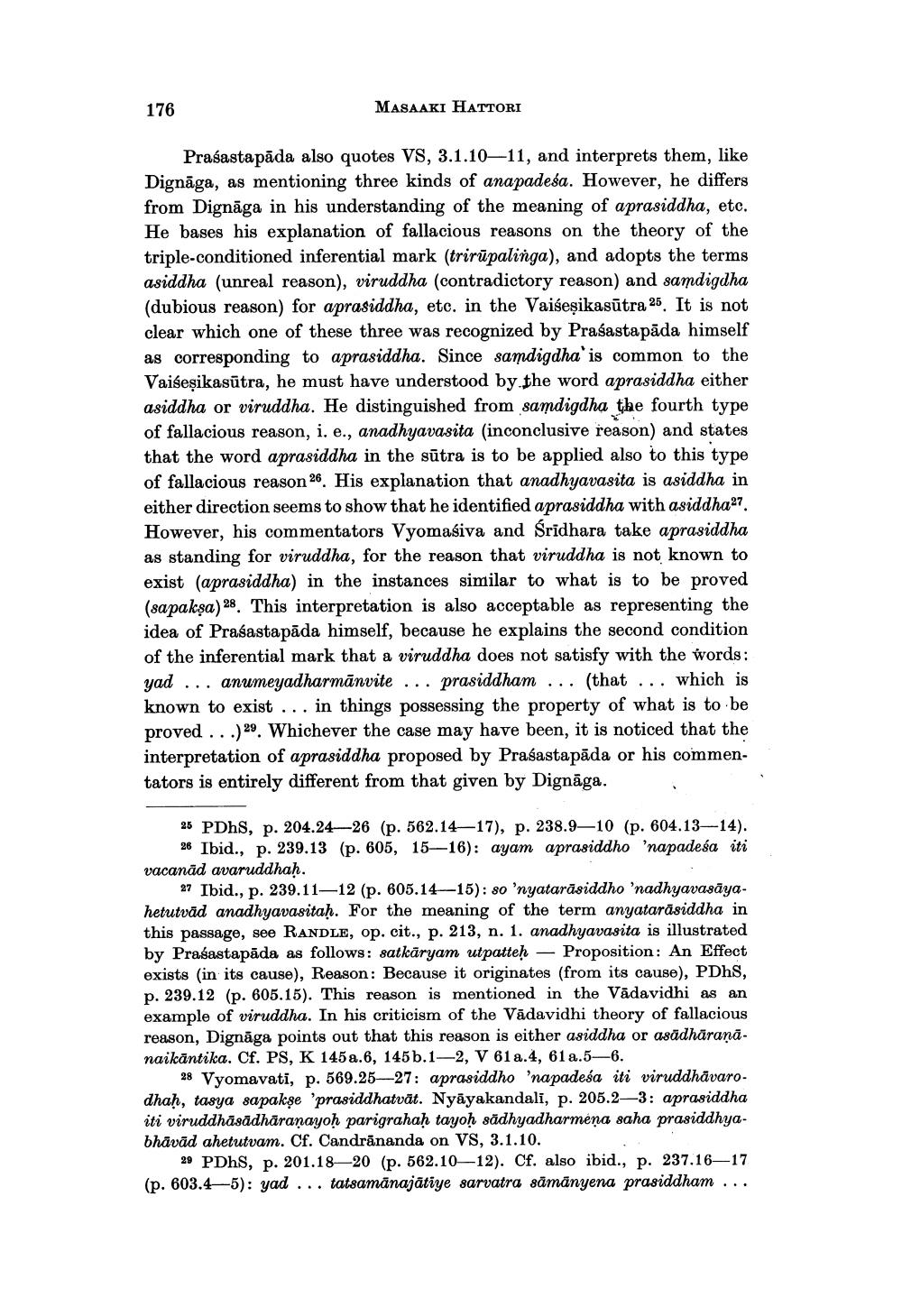Book Title: Note On Development Of Vaisesika Theory Of Anumana Author(s): Masaaki Hattori Publisher: Masaaki Hattori View full book textPage 8
________________ 176 MASAAKI HATTORI Prasastapāda also quotes VS, 3.1.10–11, and interprets them, like Dignāga, as mentioning three kinds of anapadeśa. However, he differs from Dignāga in his understanding of the meaning of aprasiddha, etc. He bases his explanation of fallacious reasons on the theory of the triple-conditioned inferential mark (trirūpalinga), and adopts the terms asiddha (unreal reason), viruddha (contradictory reason) and samdigdha (dubious reason) for aprasiddha, etc. in the Vaiseșikasūtra 25. It is not clear which one of these three was recognized by Prasastapāda himself as corresponding to aprasiddha. Since samdigdha'is common to the Vaiseşikasūtra, he must have understood by the word aprasiddha either asiddha or viruddha. He distinguished from samdigdha the fourth type of fallacious reason, i. e., anadhyavasita (inconclusive reason) and states that the word aprasiddha in the sūtra is to be applied also to this type of fallacious reason 26. His explanation that anadhyavasita is asiddha in either direction seems to show that he identified aprasiddha with asiddha27. However, his commentators Vyomasiva and Sridhara take aprasiddha as standing for viruddha, for the reason that viruddha is not known to exist (aprasiddha) in the instances similar to what is to be proved (sapaksa) 28. This interpretation is also acceptable as representing the idea of Prasastapāda himself, because he explains the second condition of the inferential mark that a viruddha does not satisfy with the words: yad ... anumeyadharmānvite ... prasiddham ... (that ... which is known to exist ... in things possessing the property of what is to be proved ...) 29. Whichever the case may have been, it is noticed that the interpretation of aprasiddha proposed by Prasastapāda or his commentators is entirely different from that given by Dignāga. 25 PDhs, p. 204.24-26 (p. 562.14—17), p. 238.9—10 (p. 604.13-14). 26 Ibid., p. 239.13 (p. 605, 15—16): ayam aprasiddho 'napadesa iti vacanăd avaruddhah. 27 Ibid., p. 239.11—12 (p. 605.14-15): so 'nyatarāsiddho 'nadhyavasāyahetutväd anadhyavasitaḥ. For the meaning of the term anyataräsiddha in this passage, see RANDLE, op. cit., p. 213, n. 1. anadhyavasita is illustrated by Prasastapāda as follows: satkāryam utpatteh — Proposition: An Effect exists in its cause), Reason: Because it originates (from its cause), PDhS, p. 239.12 (p. 605.15). This reason is mentioned in the Vādavidhi as an example of viruddha. In his criticism of the Vādavidhi theory of fallacious reason, Dignāga points out that this reason is either asiddha or asädhāraņānaikāntika. Cf. PS, K 145a.6, 145b.1-2, V 61 a.4, 61 a.5-6. 28 Vyomavati, p. 569.25—27: aprasiddho 'napadesa iti viruddhāvaro. dhah, tasya sapakşe 'prasiddhatvät. Nyāyakandali, p. 205.2-3: aprasiddha iti viruddhāsādhāranayoh parigrahaḥ tayoḥ sādhyadharmeņa saha prasiddhyabhāvād ahetutvam. Cf. Candrānanda on VS, 3.1.10. 29 PDhs, p. 201.18-20 (p. 562.10-12). Cf. also ibid., p. 237.16-17 (p. 603.4—5): yad ... tatsamānajātiye sarvatra sämänyena prasiddham ...Page Navigation
1 ... 6 7 8 9 10 11 12
